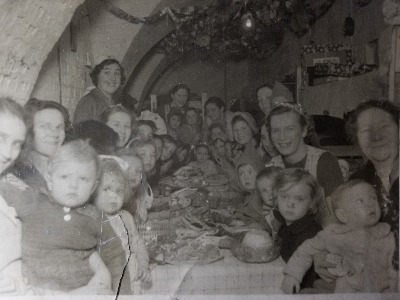In the evening of 19 March 1941, incendiary bombs hit the roof of St Alfege Church, which caught fire. A local man told us how, as a 10-year old, he watched the roof burn with his father, while two firemen fought desperately to control the flames. They stopped watching when the roof collapsed, sending a shower of sparks across the road. There were people living in the crypt at the time. One woman described to us how they first realised a bomb had hit the church when water from the fire hoses came gushing into the crypt.
Much was lost in the bombing. The old pulpit, covered with elaborate carvings by Grinling Gibbons, was wrecked beyond repair, along with most of the Tudor organ console, and Hawksmoor’s wonderful oval ceiling to the nave. However much survived, including the walls and the beautiful wooden pillars behind the altar, as well as those separating the nave from the entrance lobby. The rebuilding began in 1946, led by Professor Albert Richardson, seeking to replace as faithfully as possible what was there before, whether Thornhill’s trompe l’oeil painting above the altar or the splendid royal coat of arms beneath the organ pipes.
There were financial constraints, just as in Hawksmoor’s time, and seen most clearly in the pulpit, where the intention was to reproduce the original elaborate carved decorations. The biggest change to the church made by the renovation was probably the stained glass windows. The east window shows the risen Lord with St Alfege and Cardinal Morton kneeling beneath him. Cardinal Morton, Archbishop of Canterbury and Lord Chancellor under Henry VII, was wrongly believed to have been a vicar of St Alfege Church. Cardinal Morton has a window to himself on the right-hand side of the lobby as you enter the church from the west door.
Other windows from the renovation commemorate famous people associated with St Alfege: Thomas Tallis, the Tudor composer; General Gordon of Khartoum, who was baptized in the church; the marriage of Mary Tudor to the Earl of Suffolk, General Wolfe and St Alfege himself. On the altar of the children’s chapel beside the pulpit, a Coventry Cross of Nails reminds us that St Alfege Church was not the only church to be bombed. The restored church was rededicated in 1953. The rededication will be celebrated at a special service in April this year, part of the Hawksmoor tercentenary celebrations.
Keeping St Alfege Church open during the day has enabled many older people to share their stories with Open Church volunteers. Striking accounts of life in Greenwich during the 20th century have emerged, highlighting the poverty of the pre-war years, the hardships of the Second World War, and the extent of the bombing across Greenwich, leaving the town full of bombsites. As part of the Heritage Lottery Fund project, we hope to recreate something of the wartime experience in the crypt, where visitors can see, not far from the entrance, a sarcophagus used by a little girl as a bed..
We are very grateful to Mrs RC Barnes (Russell) who has recently shared (April 2020) this wonderful photo of a Christmas crypt party which she took part in during the war.
